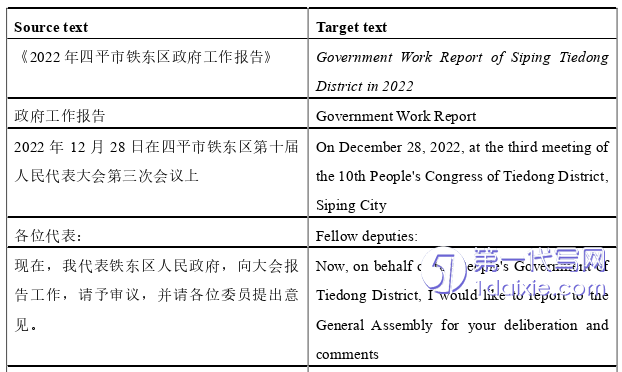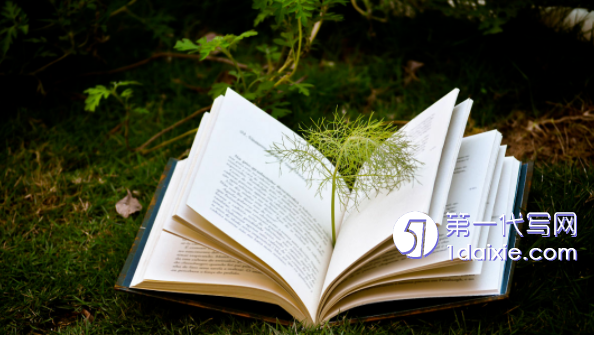本文是一篇英语论文,本翻译实践报告从词汇和句子结构两个方面进行分析,并结合适当的翻译策略。在词汇层面,原文有大量中国特色的词汇;在句子层面,原文包含大量无主句和长句。对于具有中国特色的词语的翻译,采用了直译和意译的翻译方法。
Chapter One Task Description
1.1 Background of the Translation Task
The translation of the Government Work Report is a crucial undertaking, as it represents the foremost political document issued by the Chinese government (Hu, 2018:1-1-1). With the enhancement of China's comprehensive national strength and the increasingly close connection with the world, China's position in the world is becoming increasingly important. It is in this context that we should pay more attention to the translation of government work reports. The government work report includes the guidelines, policies, and routes of local governments for the next year's work. Therefore, the government work report has a strong publicity role. However, there is a gap in the research on grassroots government work reports in China. Especially in the context of the post epidemic era, various aspects of grassroots government development need to be restarted. The construction of grassroots government governance system is an important lever for the modernization of government governance system. Grassroots governments are at the end of the administrative chain, and their administrative capabilities have a direct impact on the effectiveness of policies. It is a key connecting point between the state and society, and a key entity in dealing with the market, society, and the public. It directly provides social management and public services to the general public and enterprises. The evaluation of the government by the people is largely influenced by the quality and efficiency of grassroots government services.

1.2 Translation Process
Translating government work reports is not easy, in order to make this long translation task easier, it is necessary to make sufficient preparations for each translation process and translate it carefully. After selecting the government report, the translator needs to repeatedly read the original text and fully understood its content and style. The preparation process for translation usually includes three steps: pre-translation, while-translation, and post-translation. If the translator prepares these three pieces adequately, then the translation process will be twice the result with half the effort.
1.2.1 Pre-translation
After investigation and research by the author before the entire translation process, it was found that the existing research on the Government Work Report can be categorized into three types. The first category pertains to the investigation of translation strategies and techniques, while the second category focuses on the impact of report translation. The third category centers on the language characteristics of the Government Work Report. However, only a small number of scholars have analyzed the cognitive process of translators during the translation process.
Chapter Two Source Text Analysis
2.1 Content of the Source Text
This report is the Practice Report of Government Work Report of Siping Tiedong District in 2022. The first part of the work report is a review of work in 2022. Firstly, it describes that under the repeated pressure of the COVID-19, development of this city is facing enormous challenges. People have prevented and controlled the epidemic, stick to the bottom line of development, and safeguarded the main line of people's livelihood. Then it summarizes the six major aspects of work completed during this year: solid promotion of investment projects; Consolidate the industrial foundation while undergoing industrial transformation; Strengthen municipal construction and management; Developing social undertakings to benefit people's livelihoods and the social situation is more stable; The government construction has been enhanced step by step.
Secondly, the main content that follows is the work arrangement for 2023. It emphasized that 2023 is the coherent year for the 14th Five-Year Plan. The general requirements of the government's work are: champion the cause of socialism with Chinese characteristics, follow the guidance of Xi Jinping Thought on Socialism with Chinese Characteristics for a New Era, fully implement the guiding principles of the Party’s 20th plenary sessions of the 20th Party Central Committee; deeply implement the important instructions of General Secretary Xi Jinping's inspection of Jilin to inspect the important speech of Siping; applied the new development philosophy in full, in the right way, and in all fields of endeavor, adhere to the quality first, efficiency first, deepen the implementation of The “1355” general work idea, to transformation and upgrading as the main line, to project construction as the starting point, to reform and innovation as the driving force, focus on cracking the shortcomings, breakthrough bottleneck constraints and lead the construction of a strong socialist modern economic zone and a beautiful district Tiedong with Chinese path to modernization to make new breakthroughs.
2.2 Features of the Source Text
After pre-translation preparation and a better understanding of the original content, the next step is to have a thorough understanding of the features of the original content, which can further improve the efficiency and quality of translation, and help the author better find the parallel text materials with similar features for reference. The language style of the text is typical of government texts and the source text is official and normal. Firstly, the author analyzed the lexical features of the original text. The report contains a large number of words with Chinese characteristics, such as: 时时放心不下、铜墙铁壁、动态清零、“一企一策”、双减、“三保”、“十四五”and so on. The characteristics of these types of words are closely related to China's national conditions and cultural and political conditions, so to translate the work report, the author needs to fully understand China's national conditions and translate these words with Chinese characteristics in a way that the target language readers can understand. It also includes the names of Chinese government agencies and organizations, such as the中国共产党. This type of name needs to be translated according to the established translation method and cannot be freely used.
Chapter Three Problems and Solutions ........................ 9
3.1 Translation of China specific words ............................ 9
3.1.1 Literal Translation .............................. 10
3.1.2 Liberal translation ................................. 12
Conclusion ...................................... 22
Chapter Three Problems and Solutions
3.1 Translation of China specific words
China specific words are words that reflect Chinese culture, express Chinese connotations, and spread Chinese characteristics. It includes the unique language expression forms of Chinese language, including some political terms, phrases, and words with distinctive Chinese ethnic and cultural characteristics. In the process of translating China specific words into English, the inability to find equivalent words has become a major challenge. The concept in question may be abstract or concrete; it may relate to a religious belief, a social custom, or a type of food. Such concepts are often referred to as “culture-specific”. These headings may be described as the words, denoting things, concepts, social phenomena, etc., of the source language unfamiliar to people who share the target language (Baker, 2000). To enhance China's cultural soft power and international discourse power, it is necessary to build a Chinese discourse system, and the basic element of the Chinese discourse system is China specific words. (Zhang Yihua, 2016:7)
Wang Dongping believes that words with Chinese characteristics contain rich Chinese cultural elements, and its essence is culturally specific items. The translator first divided the words with Chinese characteristics in the “Government Work Report” into two categories: proper nouns and general terms, and then subdivided general terms into four categories: abbreviations, idioms, literary quotations, and metaphorical words. ( Wang Dongping,2020:34-40.) It is necessary to summarize some political language or professional concepts to avoid the complexity when discussing the concept every time. There are three main characteristics: generality; four-character words; metaphors. The first characteristic of these terms is their broad scope, as they pertain to various areas of Chinese society, including politics, economics, and culture, thereby reflecting the progress of China in diverse domains. During specific historical periods, these terms have reflected people’s ideologies and values concentratedly. (Liu G,Jiao Q, 2023,13(7))

Conclusion
To sum up, due to the particularity of political texts, when translating government work reports, while maintaining the characteristics and standards of translated political texts, suitable translation methods can be selected for various types of sentences. In particular, this kind of study can attempt to reveal the influence that the mainstream values of a society or the political beliefs shared by a party, a class or a country can have on translation. Conversely, it can investigate the role of translation in constructing or (re)shaping the image of a class, party or country, or its role in shaping the mainstream values of a society. It is generally acknowledged that translation is, in essence, a social activity, for translators are inevitably influenced by the values, beliefs or ideas of the social class, political party or country to which they belong to. Moreover, translation is often employed as an important tool to promote a particular value or political idea (Hu, K. & Li, X, 2018,63(3), 583–603). However, the most important standard is to ensure accurate translation of the report content, while also ensuring that the target language readers can understand it.
The government report selected belongs to the grassroot government report. The case study section mainly discusses the author’s use of translation methods to translate words with Chinese characteristics, non-subject sentences, and long sentences.
reference(omitted)
